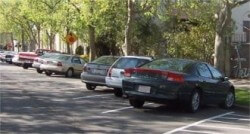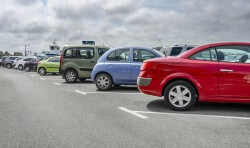Reversing & Parking - Learner Driver Tips [EBOOK] Ch 13
April 30, 2019 at 11:23 AM
In Chapter 13, learn all there is to know about reversing and parking in both manual and automatic cars along with parallel parking and parking in angled car parks.
Jump To:
13.1 HOW TO MOVE IN REVERSE (AUTOMATIC)
13.2 HOW TO MOVE IN REVERSE (MANUAL)
13.3 HOW TO REVERSE PARALLEL PARK
13.4 PARKING IN AN ANGLED PARK
13.5 REVERSING OUT OF AN ANGLED PARK
13.1 HOW TO MOVE IN REVERSE (AUTOMATIC)
The most challenging thing about moving in reverse is that you cannot see what is around you as easily as you can when moving forward. So, if you are reversing from a driveway where there ’re kids and pets present, go to the back of the car and check for obstructions before you start.
’re kids and pets present, go to the back of the car and check for obstructions before you start.
When you are ready:
- Press in the brake.
- Shift to the reverse gear.
- Check your mirrors and blind spots to see what is going on around the car.
- If all is clear, turn to your left so that you are looking out through the rear window and then start reversing. Take things slow and keep checking your mirrors and blind spots constantly.
Follow these steps to start reversing:
- Gently release the brake; the car will start to move back.
- Press the accelerator gently if you require to move faster.
- Same as steering forward, look at the point you want to steer to and not immediately outside the back window.
- When you are about a car’s length to your destination, release the accelerator and smoothly press down the brake to stop the car.
13.2 HOW TO MOVE IN REVERSE (MANUAL)
Not being able to easily see what is around you is the hardest thing about driving a car in reverse. Because of the limited visibility, make sure  to check behind your vehicle for obstacles and hazards before you begin reversing.
to check behind your vehicle for obstacles and hazards before you begin reversing.
Once you are ready:
- Press the clutch all the way in.
- Shift to the reverse gear.
- Check your mirrors and blind spots to see what is happening around the car.
If all is clear, turn your body so that you are looking out through the rear window ready to start moving and follow these steps:
- Slowly let the clutch up until you feel the car ‘bite’, hold the clutch there to avoid bunny hopping or stalling.
- Gently press the accelerator as you release the clutch slowly.
- Look where you want to go instead of immediately behind the car as you steer.
- Keep checking your mirrors and blind spots as you move.
- Once you are about a car’s length to your stopping point, press the clutch all the way in and smoothly press the brake.
Practice reversing in an empty lot before trying it out on the road.
13.3 HOW TO REVERSE PARALLEL PARK
The most important thing when reverse parallel parking is to position your car correctly before you begin. You should pull up your car a small distance in front of the car that is parked in front of the slot you want to get into;  such that your front door is next to the car’s front wheel and your car about half a metre away along its length.
such that your front door is next to the car’s front wheel and your car about half a metre away along its length.
Once in position, check for hazards and then:
- Put the car in reverse gear and turn on your left indicator if it’s not still on.
- Reverse while checking your mirrors and blind spots.
- Turn your steering to the left (about one whole turn depending on your car) once the back wheel of your car is level with the front vehicle’s rear bumper.
- When clear of the car in front, begin turning your steering to the right to put your car closer to the kerb.
- Reverse slowly until your vehicle is parallel to the kerb and about 30cm away.
- If you require to straighten up, move your car forward slightly.
- When in the correct spot, put your vehicle in Park (automatic) or Neutral (manual) and engage the handbrake.
- Practice with cones first, then move to a park with only a car in front before progressing to single parking spaces. This will help build your confidence.
The most important thing when reverse parallel parking is to position your car correctly before you begin. You should indicate to the left and pull up your car a small distance in front of the car that is parked in front of the slot you want to get into; such that your front door is next to the car’s front wheel and your car about half a metre away along its length.
Watch our video on how to do a parallel park.
13.4 PARKING IN AN ANGLED PARK
While its orientation makes it easier to drive into, it still does require some skill and technique to successfully get your car into an angled park. 
Here are the steps for parking your car in an angled park:
- Locate a vacant parking spot for your car and indicate to let other drivers know that you intend to park.
- Position your car in such a way that your side mirrors are aligned with the demarcation line that is closest to you. Move slowly so that you don’t overshoot the spot.
- When your mirrors are aligned with the first line, start turning into the spot slowly and carefully.
- Adjust your vehicle’s position as you slowly drive in so that you’re not too close to the cars on either side.
- Keep adjusting your car’s position as you move forward until your car lines up with those in adjacent parking slots. Be careful not to hit the kerb.
- Once you’re in the angled park, switch off the indicator, shift your car into neutral (for manuals) or park (for automatics) and engage the handbrake.
- Turn off the engine if you need to.If you find you’ve parked too close to either of the cars on your sides, reverse out and drive into the angled park again.
Watch our videos on: parking in an angled park on the right. & parking in an angled park on the left.
13.5 REVERSING OUT OF AN ANGLED PARK
When reversing out of an angle park, it is important to scan your surrounding and check your mirrors constantly to know everything that is going on around you. You should also back out slowly to allow other drivers to notice what you are doing and make adjustments to their driving if they need to.
everything that is going on around you. You should also back out slowly to allow other drivers to notice what you are doing and make adjustments to their driving if they need to.
Here’s the process for backing out from an angle park:
- Check your mirrors to find out how wide the space between your car and the others on either side is.
- Put your car in reverse gear and start backing out slowly.
- Look out through the back and side windows to see behind you and keep checking your mirrors to ensure your car is still a safe distance from adjacent vehicles.
- Keep reversing until your car is further back than the car adjacent to you on your left then start turning the steering wheel right. Keep track of your front right corner to ensure it doesn’t hit the car on your right.
- Keep checking behind for traffic.
- Once you’ve backed around and the car is facing the direction you want to go, straighten the steering.
- Stop the car and shift into 1st gear (manual) or into drive (automatic)
- Check your mirrors, signal right, check your blind spots and start moving.
Watch our videos on: Reversing out of an angled park from the the right & Reversing out of an angled park from the left.
Previous Chapter Next Chapter
Roundabouts Hill Work



 BOOK NOW
BOOK NOW
